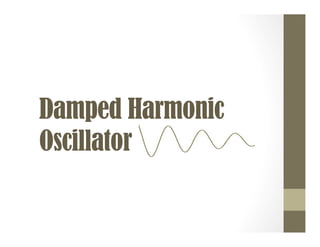
Damped harmonic oscillator - LO2
- 2. Question: • A damped harmonic oscillator of a block has mass 3.00 kg and a spring constant 10.0 N/m. The ini<al total energy of the oscillator is E(0) = 0.300 J and the amount of energy lost during four oscilla<ons is 0.140 J. Assuming that the damping force is of the form FD,x = -‐bvx, calculate1: a) The value of the damping constant b) The percentage decrease in amplitude aLer four oscilla<ons. c) The frequency of the fourth oscilla<on. How does the frequency of the fourth oscilla<on compare to the frequency of the first oscilla<on? 1. Ques<on was derived from example 13-‐11 in Physics for Scien<sts and Engineers An Interac<ve Approach.
- 3. Solution to a: First we must calculate the period. Since we are given the amount of energy lost during four oscilla<ons to be 0.150 J we can determine that the damping is weak and therefore assume that wD = w0. T = 2π/w0 = 2π√(m/k) = 2π√(3.00 kg / 10.0 N/m) = 3.44 s To find the damping constant, we must solve for b in the following equa<on: E(4T) = E(0)e-‐4bT/m We have the values for E(0), t, and m, but we need to find the value for E(4T) so that we can use the equa<on to isolate for b.
- 4. Solution to a cont’d: We know that, E(4) = E(0) – Energy lost in 4 oscilla<ons E(4) = 0.300 J – 0.140J = 0.160J Plugging this back into the previous equa<on we get, E(4T) = E(0)e-‐4bT/m 0.140 J = 0.300 J x e-‐4b x 3.44 s/ 3.00 kg 0.467 = e-‐4b x 3.44 s/ 3.00 kg ln (0.467) = (-‐4b x 3.44 s) / 3.00 kg b = ln (0.467 J) x 3.00 kg = 0.167 kg/s (-‐4 x 3.44 s)
- 5. Solution to b: Now that we know the damping constant, we can use the following equa<on to relate the amplitude at t = 0s and the amplitude aLer four oscilla<ons. Let x = the percentage of the ini<al amplitude aLer four oscilla<ons A(4T) = A*e-‐4bT/2m = x*A e-‐4bT/2m = x e(-‐4 x 0.167 kg/s x 3.44 s ) / (2 x 3.00 kg) = 0.682 Now we know the percentage of the ini<al amplitude that remains aLer four oscilla<ons. However, the ques<on is asking the percentage of amplitude that is lost aLer four oscilla<ons. Thus, 1 – 0.682 = 0.318 or 31.8% of amplitude height is lost during the four oscilla<ons.
- 6. Solution to c: Frequency is given by the formula f = 1/T Therefore, 1/ 3.44 s = 0.29 s-‐1 Frequency does not change with energy loss and therefore the frequency is the same for each oscilla<on. It is important to understand that frequency, in this context, is a measure of oscilla<ons per second. When fric<on is present, as in the case with damped harmonic oscilla<on, energy is lost with each oscilla<on. As you can see in the graph, energy is lost and amplitude decreases. However, the period and frequency remains the same! 1. Graph is from page 371 in Physics for Scien<sts and Engineers An Interac<ve Approach.